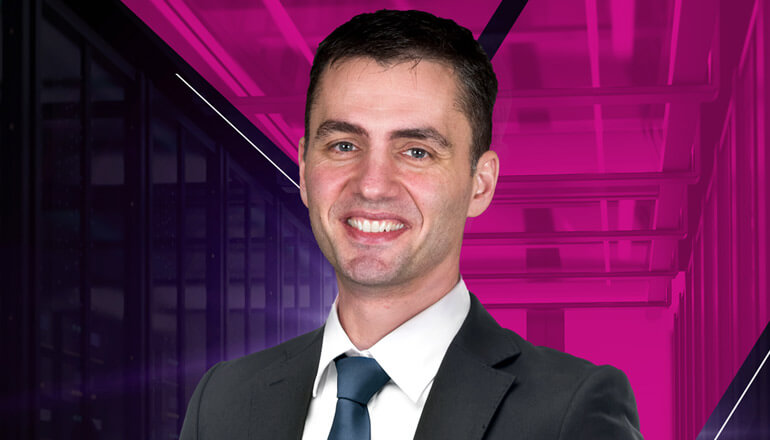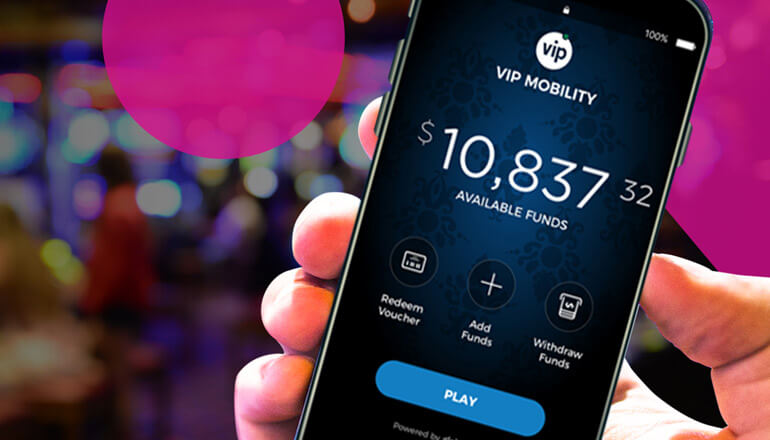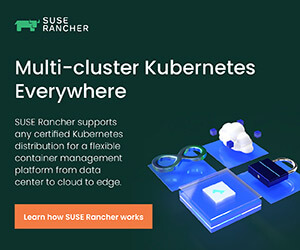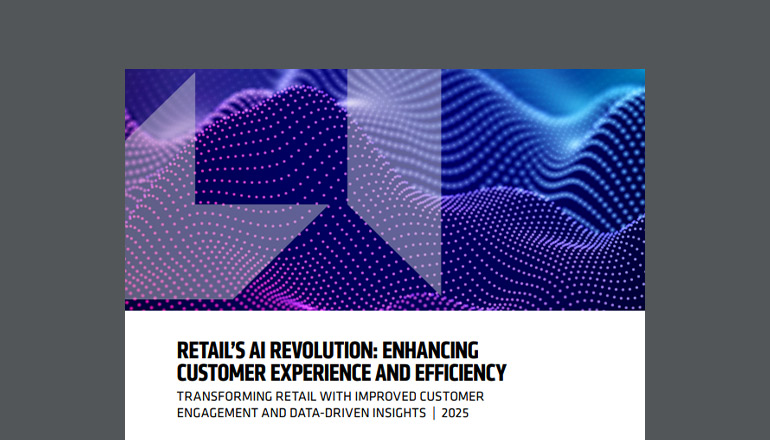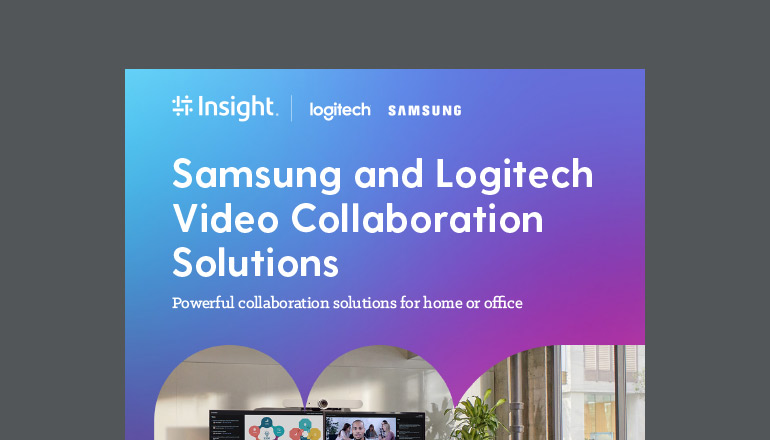Tech Journal AI, Automation and the Intelligent Edge: How Organizations Are Solving Their Most Ambitious Challenges
IT teams face a long list of priorities for 2022 — as well as substantial challenges. How are organizations overcoming the talent shortage and stepping up in an increasingly competitive market? I sat down with Insight President and CEO Joyce Mullen to find out.
By Jillian Viner / 14 Dec 2021 / Topics: Artificial Intelligence (AI) Automation Modern workplace Customer experience


Conversation with
Joyce Mullen
CEO and President, Insight
When I arrive at Joyce Mullen’s new Phoenix home for our interview, I’m greeted by her husband, Todd, who smiles warmly and tells me Joyce is on a call with a client. A crew sets up lights and plans camera angles to capture new photos of Joyce. Todd watches the production from the kitchen, a small smile of pride and amusement fixed on his face. All this hubbub for his wife, his partner, who followed her own ambitious pursuits and is now about to be documented for the next chapter of her career as Insight’s new CEO and successor to Ken Lamneck.
Joyce enters the room with a big smile and hello to everyone and asks what we need from her. A young employee who joined the video team just a few months ago sets up a microphone nearby. I observe as Joyce walks toward him, introduces herself and asks him his name.
There are two things you should know about Joyce Mullen. First, relationships are vital to her being. Since becoming president of Insight North America in October 2020, Joyce has flooded her calendar with appointments to build personal connections with Insight’s clients and teammates, never missing an opportunity to ask questions.
“I think if you approach a conversation with curiosity, big ears and an open mind, you get to better answers,” she tells me later.

“ I think if you approach a conversation with curiosity, big ears and an open mind, you get to better answers.
The second thing you should know is Joyce is ambitiously positive — and passionate — about the power of technology used for good.
When we sit down together, I have a lengthy list of curiosities for the 35-year technology veteran. But since this Tech Journal issue is dedicated to being ambitious, we start first with the ambitious goals IT teams will tackle in 2022.
Big results require ambitious goals.
In partnership with IDG, Insight conducted field research to survey 400 IT decision-makers for the Insight Intelligent Technology Report 2022: IT Ambitions for Business Transformation. The report captures the bold moves organizations made in response to the pandemic and uncovers the opportunities and challenges facing IT in the coming year.
The pandemic undeniably accelerated digital transformation. In fact, “95% of North American enterprises report that the pandemic accelerated business transformation, highlighted gaps in their transformation roadmaps or pushed them to create a roadmap in the first place,” according to the report.
But the work is far from over.
Organizations remain under pressure to modernize IT and respond to increased competitive demands. Top business priorities for IT departments in 2022 span everything from improving operational efficiencies and employee productivity to driving the speed of innovation and creating greater flexibility for anywhere work.
Top business priorities for IT departments in 2022 span everything from improving operational efficiencies and employee productivity to driving the speed of innovation and creating greater flexibility for anywhere work.
And complicating the long list of priorities is a significant talent shortage. IT took on additional responsibilities in cybersecurity, cloud architecture, procurement and analytics in 2021. At the same time, 45% of respondents reported skills and talent gaps specifically related to these areas. Understandably, over half (56%) said that sourcing talent will be a top priority over the next 12 months.
Joyce nods knowingly as I read the statistics out loud. I suspect she can’t help but smile wryly because the challenges I’m listing off are so widely shared. So I ask her, how can organizations succeed?
“First of all, you have to prioritize. You can’t do everything at once,” she says. “But what we often see is a very logical progression of work, starting with: What can we do to reduce operating expenses? If you want to free up money to do things better, you have to reduce the costs of running the core systems.”

The “Great Resignation” is an opportunity for both employee and employer.
Beyond IT roles, the pandemic disproportionately created a labor shortage among retail and quick service restaurants. “Help wanted” and “Now hiring” signs are everywhere. But my personal favorite is this one: “The whole world is short staffed. Be kind to those who showed up.”
What’s being dubbed as “The Great Resignation” is an opportunity for employees to seek meaningful, fulfilling work that also pushes organizations to look inward.
“You have to think, how do we make this a really compelling place to contribute to and recruit, and then to retain people? And this has a lot to do with not only with the quality of the work and the pay and the benefits, but also with the company purpose and values. What are the values that we exude every single day? You have to be excited about attracting teammates who really want to build value for clients over the long-term and do it in a great environment,” says Joyce.
“ You have to be excited about attracting teammates who really want to build value for clients over the long-term and do it in a great environment.
A lot of companies have shifted budget dollars to attract and retain talent. In doing so, they’re re-evaluating and investing in better employee experiences.
Solution integrators like Insight haven’t traditionally worked closely with clients’ employee experience teams, but unique challenges call for creative solutions.
As an example, Joyce tells me about a large retailer that worked with Insight to provide employees with smartphones. The familiar devices made work intuitive and simple, with functions like clocking in and out or getting real-time inventory. But the unique added value in this scenario is that employees were encouraged to take the devices home for personal use, too.
Another way companies are solving for the labor shortage and improving employee experiences: adopting greater automation.
“I think we have an opportunity and an obligation to automate many processes,” says Joyce. “This is a world of self-service and e-commerce. There are a whole lot of opportunities to take steps, touch points and cycle time out of processes. And when we automate tasks, it's generally work that people don't love doing anyway.”
Such was the case for one client, which was expending countless hours and manpower to manually scan and sort approximately 31,000 documents (300,000 pages) every month. Someone had to review each document to scan for details such as claim numbers, type of claim, number of illnesses and so on. The process was tedious and, as you might imagine if you had to review hundreds of documents each day, quite error-prone.
It was the perfect use case for automation.
Insight built an automated process utilizing cognitive services, or computer vision, to scan the documents and extract pertinent information. Machine learning worked to classify each file and automatically route it to the proper department. All in all, the solution drastically reduced lag time for processing, increased accuracy and reduced labor costs.
Computer vision is a rapidly growing technology that takes visual inputs from sources, such as images or videos, and analyzes them using algorithms, machine learning and artificial intelligence. The analysis becomes important data to help other systems make decisions.
Automation is also key for our increasingly digital-first, self-service culture.
As we talk about this, Joyce reminds me about the introduction of the airport self-service ticketing kiosks.
“I think initially, when we got to an airport and we saw those kiosks, we went straight past them and got in line to talk to a person. But now, we’ve learned that the kiosks are way faster than the people and, because we've learned we can trust what happens at those kiosks, we prefer them.”
I nod and laugh at the truth of this example, remembering also when the first self-checkout stations appeared at the grocery store and how appalled we were at their arrival. What about customer service? But now, when I’m determined to rush in and out for toilet paper and a pack of gum, I’m grateful for expedited self-service.
In practice, great customer service doesn’t require a person-to-person experience. Between a growing consumer market of digital natives and pandemic-induced zero-touch service, organizations are reconciling the need for increased digital experiences.
Adopting more automation and self-service solves for both labor shortages and better customer service. Case in point: a financial institution client of Insight recognized a need to alleviate their staff’s ordinary, routine, customer-facing tasks while also delivering a preferred customer experience.
In partnership with Insight, they developed a virtual customer assistant, or chatbot. Insight already had the foundation of the intelligent bot and deep learning models created. Through a pattern of transfer learning, the bot was tailored further to meet the client’s specific needs.
The financial institution experienced a 72% increase in digital account opening after deployment.
And, when the chatbot struggles to correctly understand and respond to an inquiry, the question or conversation gets routed to a human to determine what should have happened. Then, that information is added to the code so the bot is always getting smarter.
But, to harken back to Joyce’s ambition of tech for good, there are other human factors for deploying automation and the intelligent edge. When I ask about ambitious possibilities here, she lights up.
“I have a lot of confidence that with access to technology, we can solve almost anything,” Joyce says, and she begins to tell me about a recent meeting with a client in the medical research field. They see the potential for personalized medicine using Artificial Intelligence (AI) and the intelligent edge. Before I know it, I’m engrossed in a medical research and data science lecture rolled into one.

“I have a lot of confidence that with access to technology, we can solve almost anything.
“The human genome contains something like three billion base pairs,” she explains. “So, to map a human genome takes an amazing amount of computing power. And then you have to use AI to make sense of it (because no one can think about three billion anything). Cancer institutions may look at the 22,000 genes that are most often affiliated with the disease. But what if you could map out all three billion base pairs? So instead of covering about 90% of the likelihood of finding the answer, you cover 100% of the likelihood of figuring out what's going on with those genes.
The work this organization does is amazing and it’s ambitious, certainly. But you need that combination of computer brain power and human brain power to consume the data and make decisions about treatment.”
AI can also conduct a rapid, scrupulous quality check of every single product on a factory line, as opposed to a random sample — which is reassuring when you’re producing medical devices or treatments.
To do this, cameras set up on production lines, using computer vision, follow training models on what a “good” product looks like vs. a “bad” product.
In some tests, Insight has seen these computers identify bad products among the “good” population that human eyes had missed. When you’re producing for medical purposes, quality is critical. Why leave quality to chance with a random sample when you can ensure 100% inspections with precision?
Ambition isn’t a solo venture — but it should be your driving attitude.
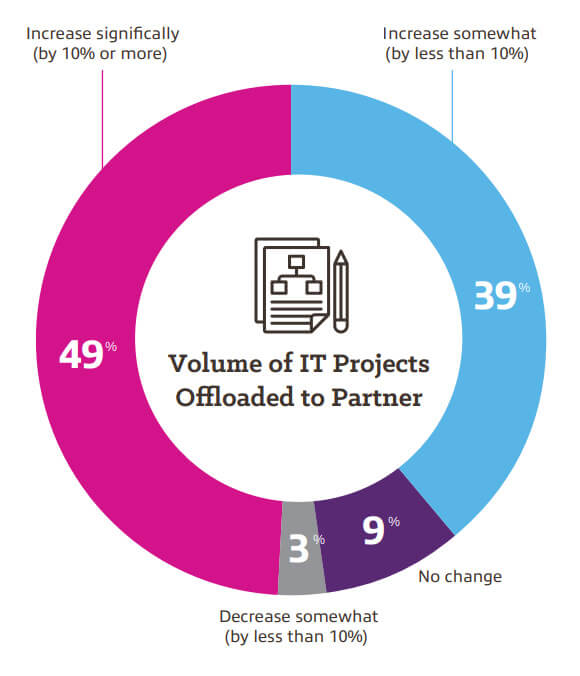
Joyce tells me that as she’s gotten to know more Insight clients, she’s seen two subsets of clients. Some organizations have a large internal team dedicated to envisioning the business transformation and just lean on Insight to help with execution.
But, she notes, “More often than not — especially when it comes to the power of data — organizations just don’t have the skills, or they haven’t dedicated the time and effort to think about business transformation. So we spend time with them to workshop and identify what their opportunities are. And we love those because we can really help them shape their strategy.”
According to the Insight Intelligent Report 2022, 95% of IT leaders indicated their organizations will rely on third parties for their business transformation strategy (53% to a great extent) and most (89%) expect the volume of IT projects offloaded to a third party to increase over the next 12 months.
“Growth stops when you stop investing in the company,” Joyce says. “Leaders need to make the commitment to be better. If you’re not curious and excited to innovate and to make the investment — and I’m not even talking about what you buy — but making the commitment to be better, then your company’s growth is stunted. Now is not the time for complacency. You have to be hungry for transformation. You have to be ambitious about IT.”



